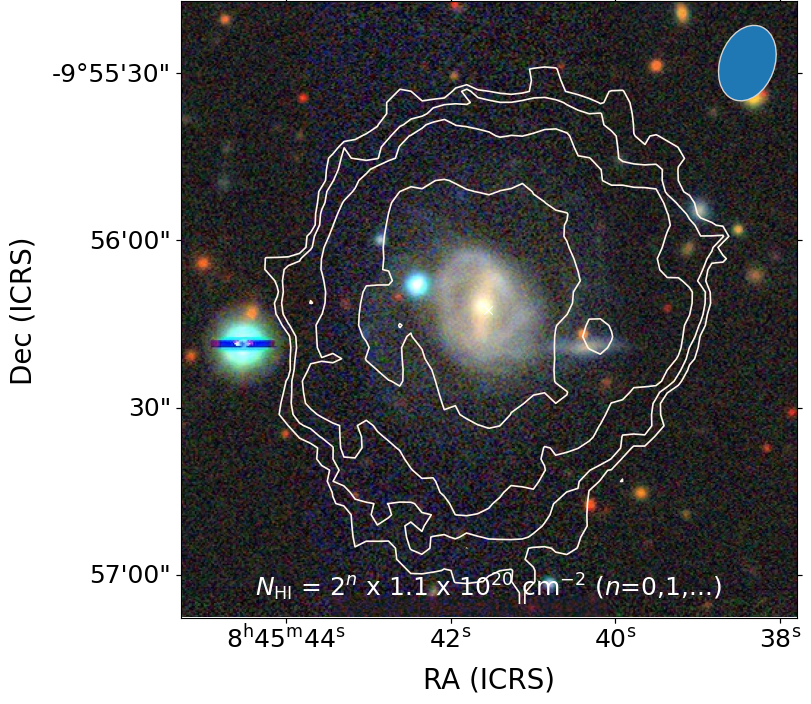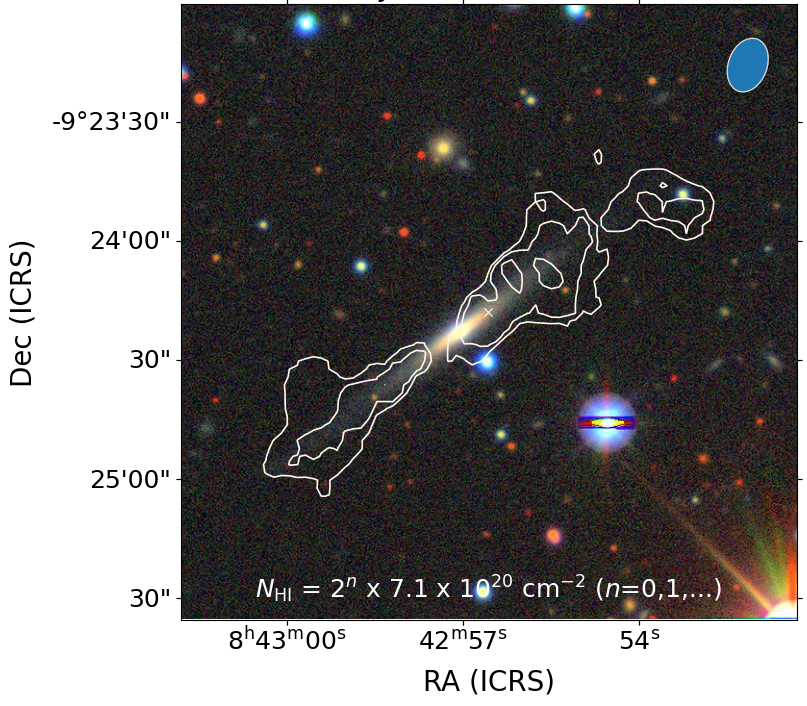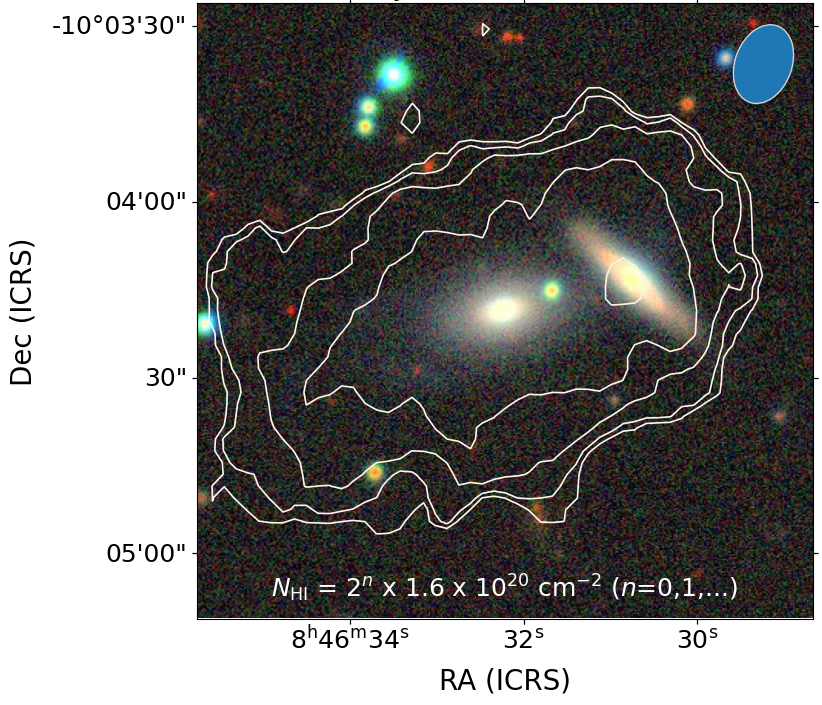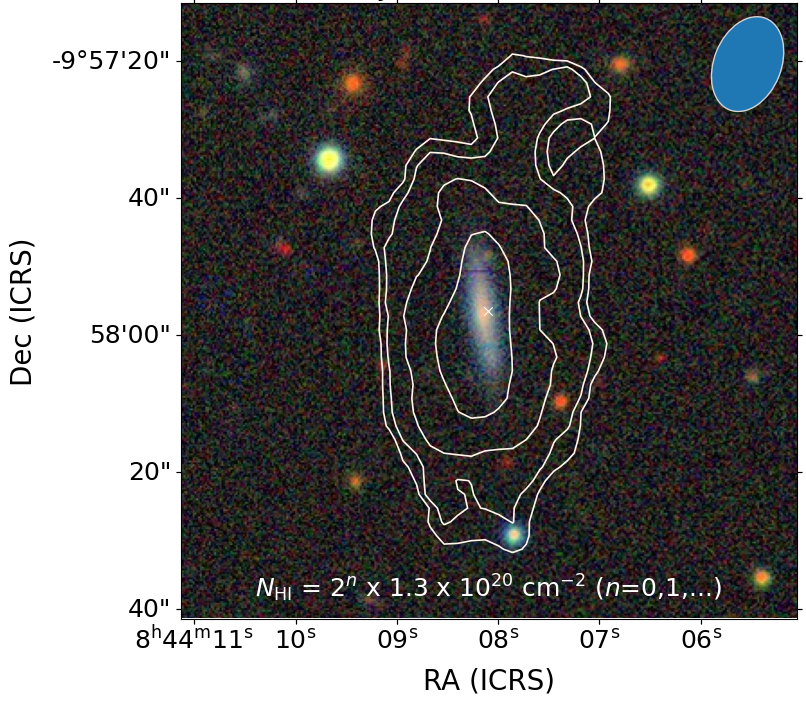The 49ers – the 49 new gas-rich galaxies detected by the MeerKAT radio telescope in South Africa. Each detection is shown as coloured contours, with redder colours indicating more distant gas from us, and bluer colours as closer gas. The background image comes from the optical PanSTARRS survey. Glowacki et al. 2024
The MeerKAT radio telescope in South Africa has once again revealed its capabilities enabling the discovery of 49 new gas-rich galaxies. From an observation barely over two hours long, this discovery, also made possible by the services provided by the Inter-University Institute for Data-Intensive Astronomy (IDIA), was far from expectations, when the original intent was to study just one galaxy. The research was published overnight in Monthly Notices of Royal Astronomical Society.
An international team of astronomers, led by Dr Marcin Glowacki from the Curtin University node of the International Centre for Radio Astronomy Research (ICRAR) in Western Australia, aimed to study a single radio galaxy. These galaxies emit radio waves due to superheated material swirling around the supermassive black hole at their centre. The team’s objective was to investigate the star-forming gas in this galaxy using the new MeerKAT radio telescope, which is the most sensitive of its kind for these studies. Although they didn’t find any star-forming gas in the galaxy they were studying, Glowacki discovered other galaxies while inspecting the data.
The MeerKAT data were analysed using the ilifu cloud computing system developed and managed by IDIA at the University of Cape Town (UCT). A powerful system that was designed to support astronomers conducting MeerKAT science. Moreover, CARTA and iDaVIE-v, software also developed by IDIA at UCT, were also used to visualise the data and ultimately reveal these new galaxies.
Prof Patrick Woudt, interim Director of IDIA, commented: “We are always very happy to see how our computer facility is providing the best environment to make discoveries such this one and in a record time scale from data gathering to analysis!” and Dr Lucia Marchetti, director of the IDIA visualisation lab at UCT where iDaVIE is developed, added “This discovery also shows the value of our innovative work in data visualisation that is providing a unique and unprecedented immersive view on the data capable of revealing the unexpected!”
In total, the gas of 49 galaxies was detected, with each finding brand new. Glowacki said this was a great example of how fantastic an instrument MeerKAT is for finding the star-forming gas in galaxies.
“I did not expect to find almost fifty new galaxies in such a short amount of time,” he said. “By implementing different techniques in finding galaxies which is used for other MeerKAT surveys such as LADUMA (Looking At the Distant Universe with the MeerKAT Array), we were able to detect all of these galaxies and reveal their gas content that MeerKAT is so good at seeing.”
The new galaxies have been informally nicknamed the 49ers – a reference to the 1849 California gold rush miners. Glowacki views the 49 new galaxies as valuable as gold nuggets in our night sky. Many of the galaxies are near each other, forming galaxy groups, with several identified in the one observation. Three galaxies in particular are directly connected to each other by their gas.
Glowacki said: “These three are particularly interesting, as by studying the galaxies at other wavelengths of light, we discovered the central one is forming a lot of stars. It is likely stealing the gas from its companion galaxies to fuel its star formation, which may lead the other two to become inactive.”
Four nearby galaxies as part of the set of 49 found by MeerKAT, shown by the white contours. Three of the galaxies are connected together by their gas content. The largest galaxy is stealing gas from two neighbouring galaxies. The background colour image is from the DECaLS DR10 optical survey. Glowacki et al. 2024
Ed Elson, a professor from the University of the Western Cape and a co-author of the paper, said: “This discovery highlights the raw power of the MeerKAT telescope as an imaging instrument. The methods we developed and implemented to study the 49ers will be useful for MeerKAT large science surveys, as well as smaller observing campaigns such as ours.”
And the finding is no accident by MeerKAT either. Recently, an ICRAR summer student (Jasmine White) working with Glowacki helped find even more gas-rich galaxies in other short observations made by MeerKAT.
“We hope to continue our studies and share even more discoveries of new gas-rich galaxies with the wider community soon,” Glowacki said.
Links:
IDIA (Inter-University Institute for Data Intensive Astronomy): https://idia.ac.za/
Ilifu cloud supercomputer: https://www.ilifu.ac.za/
IDIA Visualisation Lab: https://vislab.idia.ac.za/
MeerKAT: https://www.sarao.ac.za/science/meerkat/
ICRAR (International Centre for Radio Astronomy Research): https://www.icrar.org/
Contact details:
Dr Marcin Glowacki, Research Fellow at the Curtin University node of the International Centre for Radio Astronomy Research (ICRAR) in Western Australia
Email: marcin.glowacki@curtin.edu.au
Phone number: +61 423 486 919
Other links: https://staffportal.curtin.edu.au/staff/profile/view/marcin-glowacki-6d947f7d/ and https://www.icrar.org/people/mglowacki/
Extra Multimedia:
VIDEO 1: VR view of several 49er galaxies detected by the MeerKAT radio Telescope
A recording of many of the 49 galaxies detected by the MeerKAT radio telescope viewed through virtual reality (VR) software. The bright parts seen are the star forming gas of each galaxy. Credit: Marcin Glowacki, through the iDaVIE-v software: https://idavie.readthedocs.io/
VIDEO 2: VR zoom-in of a few galaxies detected by MeerKAT
A recording of a few of the 49 galaxies detected by the MeerKAT radio telescope viewed through virtual reality (VR) software. Here the focus is on a group of galaxies which are close together. The largest galaxy seen here is stripping two nearby galaxies of its gas to fuel its own star formation. Credit: Marcin Glowacki, through the iDaVIE-v software: https://idavie.readthedocs.io/
IMAGES:




Examples of individual detections of the gas detected by MeerKAT (white contours) on top of a three-colour optical image from the DECaLS DR10 survey. The gas seen here extends further out than the stars in the galaxies. Glowacki et al. 2024.
